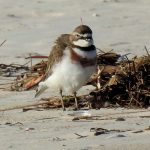DOUBLE-BANDED PLOVER
(Charadrius bicinctus)
The Double-banded Plover is a small and charming shorebird that graces the coastal regions with its presence, particularly in New Zealand and parts of Australia. In Australia, it is more commonly known as the Banded Dotterel.
During the warmer months, these birds can be found in New Zealand, where they breed. They prefer riverbeds, estuaries, and open country for their breeding grounds. The Double-banded Plover is a creature of habit, often returning to the same site each year to mate and nest. Their nests are simple scrapes in the ground, often lined with small stones or vegetation. The ‘double bands’ for which they are named are the two distinctive black bands across their chest, which stand out against their otherwise sandy and white plumage.
As the southern hemisphere winter approaches, many of these birds embark on a remarkable journey across the Tasman Sea to the eastern coastline of Australia. Here, they spend the cooler months in a relatively milder climate. During this time, they may be heard , and can be spotted along sandy beaches, mudflats, and sometimes even in saltmarshes and coastal lakes, foraging for invertebrates such as worms and crustaceans.
The Double-banded Plover is a species that captures the essence of resilience and adaptability. Despite their small size, they are long-distance migrants, capable of flying thousands of kilometres across open ocean.
The sight of a Double-banded Plover is a treat for birdwatchers and nature lovers alike. Their delicate movements as they scurry along the shore, stopping to tilt their heads and listen for prey beneath the surface, is a dance of survival and grace.
Like many shorebirds, the Double-banded Plover faces threats from habitat loss and disturbance during the breeding season. Their reliance on specific coastal environments means that conservation of these areas is crucial for their continued survival. Observing these birds in the wild is not only a joy but also a reminder of the delicate balance of ecosystems and the importance of protecting natural habitats for the myriad species that depend on them.

